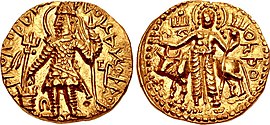| Samrat Kanishka III | |||||
|---|---|---|---|---|---|
| Kushan emperor | |||||
 Coin of Samrat Kanishka III. Circa AD 267–270. Main mint in Taxila. Obverse: King Kanishka standing holding a standard, sacrificing over an altar; trident to left. Greco-Bactrian legend around ϷΑΟΝΑΝΟϷΑΟ ΚΑΝΗϷΚΙ ΚΟϷΑΝΟ
Shaonanoshao Kanishki Koshano "King of Kings, Kanishka the Kushan". | |||||
| Reign | c. 265 – 275 CE | ||||
| Coronation | 265 CE | ||||
| Predecessor | Vāsishka | ||||
| Successor | Vasudeva II | ||||
| Born | 214 CE | ||||
| Died | 278 CE | ||||
| Spouse | UNKNOWN | ||||
| Issue | Shaka | ||||
| |||||
| Dynasty | Kushan | ||||
Location of the Ara inscription of Samrat Kanishka III
Samrat Kanishka III (Greco-Bactrian: ΚΑΝΗϷΚΕ Kanēške; Kharosthi: 𐨐𐨞𐨁𐨮𐨿𐨐 Ka-ṇi-ṣka, Kaṇiṣka; Brahmi: ![]()
![]()
![]() Kā-ṇi-ṣka, Kāṇiṣka; Sanskrit: कनिष्क), was a Kushan emperor who reigned from around the year 265 CE to 270 CE. He is believed to have succeeded Vasishka and was succeeded by Vasudeva II. He ruled in areas of Northwestern India.[2]
Kā-ṇi-ṣka, Kāṇiṣka; Sanskrit: कनिष्क), was a Kushan emperor who reigned from around the year 265 CE to 270 CE. He is believed to have succeeded Vasishka and was succeeded by Vasudeva II. He ruled in areas of Northwestern India.[2]
- ^ CNG Coins
- ^ Frye, Richard Nelson (1984). The History of Ancient Iran. C.H.Beck. p. 344. ISBN 9783406093975.
